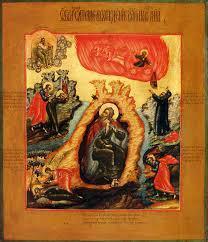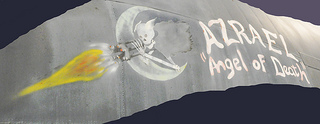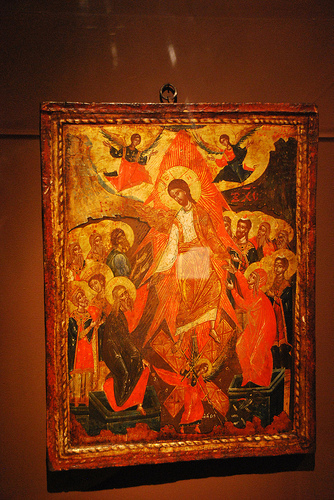Stephen Hayes's Blog, page 52
October 2, 2014
Neoliberalism and the Gospel
And Elijah came unto all the people, and said, How long halt ye between two opinions? if the LORD be God, follow him: but if Baal, then follow him. And the people answered him not a word (I Kings 18:21).
It seems to me that for many Christians the Gospel of Neoliberalism has replaced the Gospel of Jesus Christ.
I’ve known that for a long time, and have blogged about it before (here, and here, and here).
But today I was reminded of it again when several people brought various articles on it to my attention:
Neoliberalism has brought out the worst in us
Sick of this market-driven world? You should be
Counterscript
As one of these articles points out, Neoliberalism has brought out the worst in us | Paul Verhaeghe | Comment is free | theguardian.com:
Bullying used to be confined to schools; now it is a common feature of the workplace. This is a typical symptom of the impotent venting their frustration on the weak – in psychology it’s known as displaced aggression. There is a buried sense of fear, ranging from performance anxiety to a broader social fear of the threatening other.
Constant evaluations at work cause a decline in autonomy and a growing dependence on external, often shifting, norms. This results in what the sociologist Richard Sennett has aptly described as the “infantilisation of the workers”.
And this Sick of this market-driven world? You should be | George Monbiot | Comment is free | The Guardian:
Today the dominant narrative is that of market fundamentalism, widely known in Europe as neoliberalism. The story it tells is that the market can resolve almost all social, economic and political problems. The less the state regulates and taxes us, the better off we will be. Public services should be privatised, public spending should be cut, and business should be freed from social control. In countries such as the UK and the US, this story has shaped our norms and values for around 35 years: since Thatcher and Reagan came to power. It is rapidly colonising the rest of the world.
But in some ways this point is the most telling, and raises the question that Elijah put to the Israel of old: Sick of this market-driven world? You should be | George Monbiot | Comment is free | The Guardian:
Neoliberalism draws on the ancient Greek idea that our ethics are innate (and governed by a state of nature it calls the market) and on the Christian idea that humankind is inherently selfish and acquisitive. Rather than seeking to suppress these characteristics, neoliberalism celebrates them: it claims that unrestricted competition, driven by self-interest, leads to innovation and economic growth, enhancing the welfare of all.
When a Christian script was running in many people’s minds (see Counterscript to know what that refers to) Greed was regarded as one of the Seven Deadly Sins, but in the Gospel according to Neoliberalism, it is the supreme virtue.
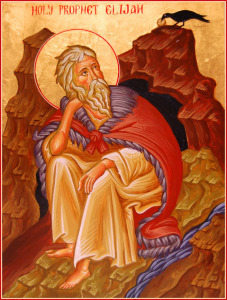 And for many Christians, the Neoliberal script has started to drown out the Christian one, and so raises the question of Elijah: How long halt ye between two opinions? if the LORD be God, follow him: but if Baal, then follow him.
And for many Christians, the Neoliberal script has started to drown out the Christian one, and so raises the question of Elijah: How long halt ye between two opinions? if the LORD be God, follow him: but if Baal, then follow him.
“Baal” is a word that means lord or master, and the deity referred to was Melqart, the god of the Phoenician city of Tyre. Melqart was a god of rain and fertility, and hence of material prosperity, and was invoked by Phoenician traders for protection of their commercial enterprises. In other words, the cult of Baal was a prosperity cult, which had lured the people of Israel, and was actively promoted by their Phoenician queen Jezebel, the wife of King Ahab. The people of Israel had the prosperity script playing in their minds.
In our day too, many Christians have the prosperity script playing in their minds.
The post immediately preceding this one, on Neopentecostal churches and their celebrity pastors, points to a phenomenon that Christian missiologists like to refer to as inculturation or contextualisation, which, in a good sense, means making the Christian gospel understandable to people living in a particular culture or context. But in the prosperity gospel preached by some Neopentecostals, the Christian gospel has been swamped by the values of Neoliberalism. One could say that “prosperity theology” is the contextualisation of the Christian gospel in a society dominated by Neoliberal values, but to such an extent that the result is syncretism.
But while the Neopentecostals sometimes do this explicitly, many other Christian groups do it implicitly, and we need to ask ourselves where our values really come from — from the gospel of Jesus Christ, or from the gospel of the Market. Jesus Christ is the love of God incarnate, but the Market, or Melqart, or Mammon, is the love of money incarnate.
When the world urges us to celebrate the virtues of Greed, whether subtly or blatantly, do we resist it? Are we even aware of what is happening? Or do we simply allow that script to play in our heads, telling us “You deserve it”?
Last week a couple of journalists were asking me why Neopentecostal churches that preach a properity gospel, like T.B. Joshua’s Synagogue Church of all Nations, are growing in popularity, and one answer is that given by George Monbiot in the article quoted above — that the values of Neoliberalism, promoted by Reagan and Thatcher, are now colonising the whole world.


September 19, 2014
Neopentecostal megachurches and their celebrity pastors
“IT DOESN’T matter how many people come to services,” says Temitope Joshua, pastor of Nigeria’s Synagogue Church of All Nations. “It’s about how many people are being saved.” But it is the sheer size of his flock in Lagos that marks out Mr Joshua, better known as Prophet T B Joshua, who runs one of Africa’s mega-churches; 15,000 people attend his services every Sunday. A lot more watch his channel, Emmanuel TV.
via Religion in Africa: Celebrity priests | The Economist.
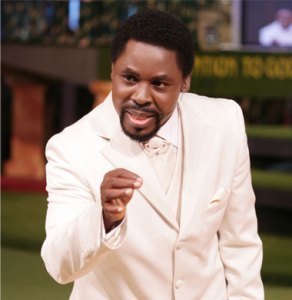
“Prophet” T.B. Joshua
The recent collapse of a guesthouse at the headquarters of T.B. Joshua’s Synagogue Church of All Nations. in which dozens of South Africans died, has led to questions in the South African media about the popularity of “charismatic churches”, and why people travel from South Africa to Nigeria in search of healing. And this came shortly after the news that an aircraft owned by another Nigerian celebrity pastor, Ayo Oritsejafor, was allegedly used to bring money to South Africa to purchase arms for the Nigerian intelligence organisation.
As the article in The Economist suggests, T.B. Joshua’s Synagogue Church of All Nations is similar to other neopentecostal negachurches found in Africa and other continents.
How and why these new denominations arose is still a matter for debate among missiologists and church historians, but here’s a brief summary:
The Pentecostal/Charismatic movement in Christianity is commonly said to have occurred in three “waves”:
First Wave (1900-1950) Pentecostal Movement. This led to the establishment of Pentecostal, Zionist and Apostolic Churches in South Africa and elsewhere, eg Assemblies of God, ZCC and numerous other Zionist denominations. White-led groups tended to be called Pentecostal, black-led groups tended to be called Zionist, and tended to develop differently, partly because of apartheid.
Second Wave: (1950-1980) Charismatic Renewal Movement. This was a revival of interest in the Holy Spirit in non-Pentecostal denominations, which led to some phenomena similar to those found in “classical Pentecostal” denominations – speaking in tongues, healing etc. In South Africa it affected mainly the Anglican, Presbyterian and Roman Catholic Churches though others were also affected. There was also some controversy, as some people within these denominations rejected the new movement for various reasons, and in some cases this opposition led some members, including some clergy, to leave and join….
Third Wave (1980-2010) Neopentecostal Megachurches. These were new denominations, formed in various countries, including South Africa, Nigeria, USA and elsewhere. They sometimes gathered people from the 2nd wave movements mentioned above, who were frustrated by the opposition to the charismatic renewal movement in the mainline churches. The main emphasis shifted away from speaking in tongues to healing and exorcism, and, in some instances an emphasis on material prosperity.
There are some home-grown South African neopentecostal denominations, like the Rhema Bible Church of Ray McCauley, the Tyrannus Apostolic Church of Simon Mokoena, the Grace Bible Church of Mosa Sona, and possibly the International Pentecostal Church of Frederick Modise.
This is a bit of an over-simplification, since the so-called “Third Wave” took some other forms as well as megachurches, for example in the Vineyard movement, and the Restorationist movement, which advocated house churches. The Second Wave — Pentecostal manifestations in non-Pentecostal denominations — has also taken on new forms. An example of this in South Africa is Anglicans Ablaze, whose national conferences attract several thousand people (and little media attention). But the megachurch phenomenon is the one that has probably had most impact on the news media, and therefore on the general public.
Some of the megachurches have expanded to other countries in Africa, and some based in other countries, like T.B. Joshua’s church, have members in South Africa and elsewhere in the continent. Another foreign-based Neopentecostal church with many branches in South Africa is the Universal Church of the Kingdom of God, which originated in Brazil.
Five of the best-known celebrity pastors in Nigeria, whose denominations have branches in other parts of the continent and overseas, are:
Adeboye, Enoch Adejare
Born: 1942
Redeemed Christian Church of God
Joshua, Temitope Balogun
Born: 12-Jun-1963
Synagogue Church of All Nations (SCOAN)
Oritsejafor, Ayo Joseph
Word of Life Bible Church
Oyakhilome, Chris
Christ Embassy
Oyedepo, David Olaniyi
Born: 27-Sep-1954
Winners Chapel
The phenomenon of neopentecostal megachurches has its origins in several different movements, which have combined.
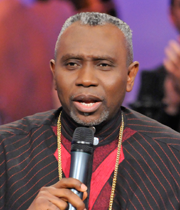
Ayo Oritsejafor – Nigerian celebrity pastor
The megachurch concept was developed and advocated by David Yonggi Cho, who wrote several books about it. These books were read quite widely around the world, and some of those who read them tried to implement the ideas in them, and a kind of megachurch ecclesiology developed, which seemed to go along with the figure of the founder becoming a celebrity pastor.
Another influence was the so-called “Word-Faith” teaching, associated with the names of Kenneth Hagin and Kenneth Copeland, also known as Prosperity Theology, or the Prosperity Gospel. This was spread through audio and video tapes of their sermons, which circulated widely in charismatic circles, and were particularly attractive to megachurch leaders, who had large and expensive buildings to maintain, and had a constant urge to pull down their barns and build bigger ones. Many of those who adopted this teaching took it out of context, and gave it an exaggerated importance which caused even its founder to have second thoughts: Kenneth Hagin Sr.’s Renouncement of Word-Faith Teachings:
Charismatic Bible teacher Kenneth Hagin Sr. is considered the father of the so-called prosperity gospel. The folksy, self-trained “Dad Hagin” started a grass-roots movement in Oklahoma that produced a Bible college and a crop of famous preachers including Kenneth Copeland, Jerry Savelle, Charles Capps, Jesse DuPlantis, Creflo Dollar and dozens of others—all of whom teach that Christians who give generously should expect financial rewards on this side of heaven.
Hagin taught that God was not glorified by poverty and that preachers do not have to be poor. But before he died in 2003 and left his Rhema Bible Training Center in the hands of his son, Kenneth Hagin Jr., he summoned many of his colleagues to Tulsa to rebuke them for distorting his message. He was not happy that some of his followers were manipulating the Bible to support what he viewed as greed and selfish indulgence.
Again, this was not an isolated phenomenon, nor unique to Pentecostal and charismatic circles. In the 1960s an Anglican priest in Johannesburg, Norman Luyt, preached the gospel of money in parishes that at that time had not been influenced by the chartismatic movement at all, and was so good at it that he was made an Archdeacon. “Success appeals to those who love success, and all men do” he used to proclaim, saying that in order to appeal to the world, the church must polish its image to make it look like a big success. The clergy should live in big houses and drive expensive cars. I doubt that he had ever heard of Kenneth Hagin, even though his message was not all that much different. But it was Kenneth Hagin’s books and tapes that circled the globe, and promoted the ideas that led to the celebrity pastors of today.
It is misleading to refer to the neopentecostal churches as “charismatic churches”, as some do, which leads many to confuse the charismatic movement with the prosperity gospel, and the charismatic miovement was much wider, and has had many different manifestations. Not all charismatic churches adopted the prosperity gospel, and many have explicitly rejected it.
For more reasons for the growing popularity of neopentecostal megachurches, see here, and for more on the charismatic movement in southern Africa, see here.


September 18, 2014
Nigeria church guesthouse collapse: the blame game
The news of the collapse of a church guest house in Lagos, Nigeria, has gradually filtered through to South Africa. The first reports suggested that the church itself had collapsed, and later reports said that 67 South Africans had been killed. And then the blame game started, with the media and the Twitterati and even the pastor of the church, T.B. Joshua, looking for a scapegoat.
Well, not everyone was looking for a scapegoat, as this article shows: Shock, condolences after Nigeria building collapse | News24:
Citizens, religious leaders, and organisations expressed their condolences on Wednesday after dozens of people, including 67 South Africans, were killed in a building collapse in Nigeria.
But condolences were rather muted, and many people seemed to feel the need to attack someone, anyone, perhaps because it makes them feel better. I suppose that must count as a “normal” human reaction. After all, after the collapse of the World Trade Centre in 2001 the US Government killed several thousand people in Iraq, who had nothing, nothing at all, to do with the collapse, simply because it made some Americans feel better.
Maybe it is the same thing that made so many people angry with Judge Thokozile Masipha because she found Oscar Pistorius guilty of culpable homicide rather than murder. And so we see the angry birds tweeting things like:
Nhlonipho Nkosi @Nipho_Reserved 21mNo kingdom has shed more blood than the kingdom of God.
#NigeriaCollapse
Ngoakza @ngoakot 26mThe collapse of TB Joshua’s church has given him so much PR, he must be a very happy man
#NigeriaCollapse
Some have blamed the South African government for not “doing something”, some blame the Nigerian government. And some have blamed the victims for going to a church in Nigeria instead of one in South Africa.
The media have reported T.B. Joshua as saying that it was a plot to kill him, referring to an aircraft seen in CCTV footage apparently flying over the building. Some have therefore blamed him for being callous and insensitive, and being more concerned with himself than with those of his followers who had lost their lives. But we don’t know that. The media choose to give prominence to some statements and not to others, and may calculate conspiracy theories are more likely to sell newspapers than condolences, and so give prominence to the former and play down the latter.
So who, or what is to blame, and for what?
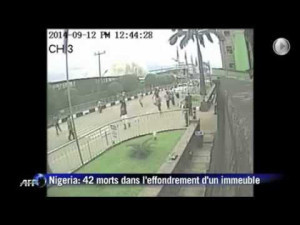
CCTV footage of the guest house collapse
I’ve seen the collapse of the building replayed many times on TV. It happened so fast that you could see that passers-by in the street were unaware of what had happened until the sound reached them a little while later, when the building had already disappeared.
It happened so fast, and was so complete that it would take several days to know how many people were in the building at the time, never mind who they were and which countries they were from. As a guest house it probably had records of who the guests were, but those records would also have been buried under the rubble, so neither the Nigerian Government nor the South African government could fairly be blamed for not having such information immediately at their fingertips.
And the South African government is pretty good at looking after their citizens in that way. A couple of months ago my daughter had a bike crash in Athens. A guy who was stoned on alcohol or something else suddenly stepped out from behind a parked vehicle as she was going down a hill. Her bike was a mess and she and the bloke she hit were bruised and grazed, but no broken bones. A few days later the South African Embassy phoned to check if she was OK. She hadn’t reported it to them. The police must have reported to the embassy that a South African citizen was involved in an accident, and they took the trouble to check. If they can do that in a relatively minor incident like a bike accident, I’m sure they are doing everything they can for those involved in the building collapse.
Some have sought to blame the victims, and have questioned why they were going to a church in Nigeria, rather than one at home, or saying that all religious people are gullible. But in South Africa we have freedom of religion, and we are free to travel to Mecca or Mount Athos or Rome or Las Vegas for religious reasons if we want to. I’ve stayed at church guest houses in Moscow and Hong Kong, and possibly a few other places I can’t now remember. Perhaps the most apt tweet for this kind of attitude was
Johannes Richter @jgmrichter 1h“… those 18 who died when the tower in siloam fell on them, were they more guilty than anyone else?”
#NigeriaCollapse#victimblaming
Some, no doubt inspired by the Oscar Pistorius case, have pointed dolus eventualis in T.B. Joshua’s direction. That would mean that he expected the building to collapse and didn’t care who was inside when it did, perhaps to claim on the insurance.
As far as I can see, the most likely causes of the collapse are one or more of:
Bad building materials
Bad workmanship
Sabotage
It is up to the Lagos municipal authorities who are responsible for building plans and codes to investigate what went wrong, and, if anyone is to blame, it is up to the judicial and law enforcement authorities to deal with them.
But, I suspect that, even if that happens, many people will not be happy. Because justice is not enough. We don’t want justice, we want vengeance, and it doesn’t matter who we take vengeance on, as long as it makes us feel better. And that makes us no better than Boko Haram, and a good deal worse than Oscar Pistorius.
What more can we say but, Lord have mercy? And Memory Eternal for those who died. Whatever their faults and imperfections, they were seeking God.
He that answereth a matter before he heareth it, it is folly and shame unto him (Poverbs 18:13).


September 10, 2014
Memory Eternal: Pope Petros & his companions
It is 10 years since Pope Petros and his companions died in a helicopter crash in the Aegean Sea near Mount Athos on 11 September 2004.
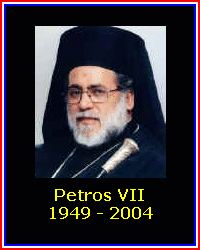 Now, ten years later, it is much easier to find news stories of the event than it was at the time. There is this, for example:
Now, ten years later, it is much easier to find news stories of the event than it was at the time. There is this, for example:
Greek Patriarch Killed in Crash – Novinite.com – Sofia News Agency:
The spiritual leader of Greek Orthodox Christians in Africa has died in a helicopter crash off northern Greece.
Patriarch Petros VII of Alexandria was going to a monastic community on Mount Athos for a religious event.
Sixteen other people were killed in the crash.
and I have even, for the first time, managed to find a complete obituary published in an English-language newspaper:
Patriarch Petros VII of Alexandria – Telegraph:
His Beatitude Petros VII , who died in a helicopter accident on Saturday aged 55, was the Pope and Patriarch of Alexandria, namely the head of the Eastern or Greek Orthodox Church in Africa; by tradition, he was the 128th successor in that office to St Mark the Evangelist.
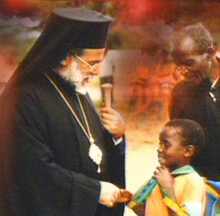
His Beatitude Petros VII, Pope and Patriarch of Alexandria and all Africa
Petros had taken charge in 1997 of a see much diminished in size and importance since its heyday during the first four centuries of the Christian Church, when from Byzantium to Seville the faithful were united and followed a common rite. At the Council of Nicaea in 325, where the Creed was formulated, the three centres of the religion were deemed to be Rome, Alexandria and Antioch – the greatest cities of the Roman Empire – with Alexandria supreme in the East.Like the Bishop of Rome, who held a particular place of honour but did not outrank his coevals, Alexandria’s Patriarch was called a Pope; his other honorific titles included Shepherd of Shepherds, Thirteenth Apostle, and Judge of the World. (Read the rest here).
And I have even, for the first time since the crash, managed to find some news reports mentioning some of the others who died in the crash. Perhaps Google search is more efficienct than it was in 2004.
Before becoming a bishop Pope Petros served as a parish priest in Johannesburg and was known to many here in South Africa as a loving pastor.
Australian bishop dies in air crash off Greece – World – www.smh.com.au:
An Australian senior cleric of the Greek Orthodox Church is among 17 victims of a helicopter crash that also claimed the life of the church’s spiritual leader in Africa, the Patriarch of Alexandria, Peter VII.
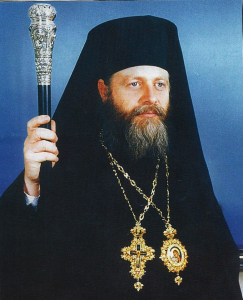
Bishop Nectarius of Madagascar
The group was heading for the Mount Athos monastery in northern Greece, one of the holiest sites in Orthodox Christianity, in a Greek Army helicopter when it disappeared from radar screens.
Archdeacon Sophronius Konidaris, personal deacon to Archbishop Stylianos, of the Greek Orthodox Archdiocese of Australia, yesterday paid tribute to the Australian, Bishop Nektarios of Madagascar, whom he described as a humble cleric and pioneer missionary.
“We are all very shocked by his death. He was very placid, a very unassuming, very loving man who dedicated his life to the people of Madagascar. He had an established life here, was an ordained cleric serving in the Gold Coast and mostly Adelaide, but he chose to leave everything to go to Madagascar.


September 7, 2014
Life is tough in Mamelodi
This morning we fetched Grace Malahlela and her mother Alinah and Grace’s two grandchildren, and gave them a life to Christina Mothapo’s house where we join them and a few others for the Hours and Readers Service every second Sunday. Alinah has a bad leg, and that is why she needs a lift. On the way Grace told us the latest bad news: they fear there is a serial killer in Mamelodi.
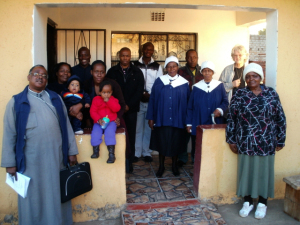
Mamelodi church meeting 30 July 2011
A young girl was murdered in their street last week, and another a few streets away, and yet another in Mamelodi West. This was the big topic of conversation after the service, and it seems that many people are very scared.
But there was also good news, or at least mixed news. Christina said the Tshwane Municipality was offering to replace roofs that had been damaged in a hailstorm last year. Her roof had been badly damaged, but she had already replaced it, and it had cost quite a bit of money. We suggested that she ask if the municipality would be willing to reimburse her for at least some of the cost of repairing the roof.

Christina Mothapo’s house on the inside, in the sitting room where we normally hold services, showing the holes in the roof
The old roof had been asbestos, and she had replaced it with galvanised iron. Many of the apartheid era council houses in Mamelodi had asbestos roofs.
But it was good to hear that the municipality was doing something to help the poorer residents.
But when we got home there was more bad news from Mamelodi, though not one that had been a topic of conversation among the residents we had been with. For the media, at least, Mamelodi seems to be the drug capital of South Africa, and this has led to an increase in crime as addicts steal to feed their habit. Perhaps one of the worst aspects, not really mentioned in the article, is that antiretroviral drugs are stolen or bought from Aids sufferers to be used as an ingredient of nyaope.
Welcome to Nyaope Street – City Press:
The 150m-long street with no official name is home to one of the notorious drug dens that have proliferated since the early noughties, when nyaope – a mixture of heroin, rat poison, dagga and sometimes antiretroviral drugs – was first sold in the township.
Mamelodi, which has the distinction of being the home of the late struggle hero Solomon Mahlangu, also has the unenviable title as the township most ravaged by this drug. Four out of five households have at least one member addicted to it, says local anti-drug group Thandanani.
Mamelodi’s Solomon Mahlangu Freedom Square has also fallen foul of the drug’s users, who have stolen cement and building equipment to fund their addiction. Curiously, the bronze statue of Mahlangu remains untouched.
On that Tuesday morning, the young people crouch, engrossed in their hand-rolled cigarettes. When City Press approaches, they stand, alarmed, only lowering their guard when we are introduced by Edgar Masuku, coordinator of the Stanza Bopape Health and Community Development Centre.
They are too ashamed to be named, wishing to spare their families further embarrassment, but they are willing to be photographed.


September 1, 2014
Church planting in Madidi
About 18 months ago Fr Markos Manyeke started to build himself a house in Madidi, on the remote north-western edge of the City of Tshwane (actually beyond Klipgat, in North-West Province). He also started to gather a group of people, neighbours, and started to teach them about the Orthodox Christian faith. They worship in a small tin shack just down the road from his house. Last Saturday Fr Athanasius Akunda and I visited them.
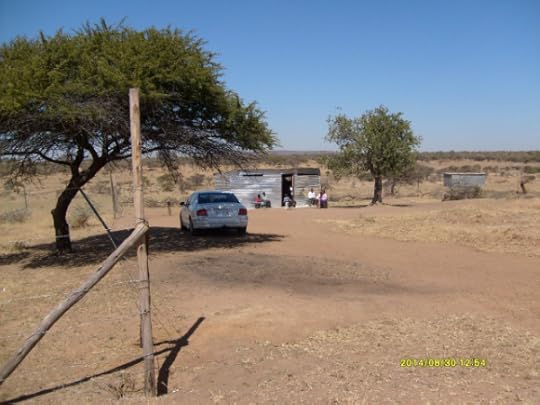
The shack church at Madidi.
The land belonged to a member of the congregation who allowed them to use the land, but he has since died, and there seem to be some problems in settling his estate, so they are looking for a new place to worship.
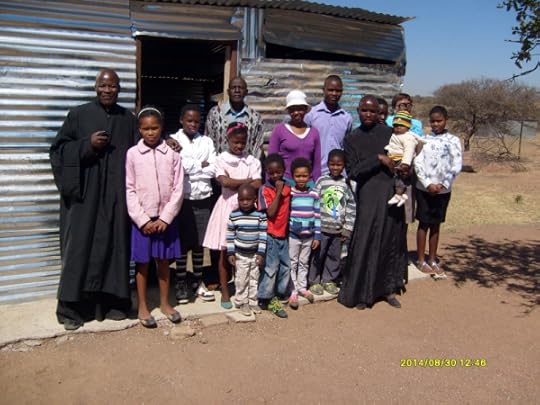
The ad hoc congregation that gathered to meet us on a Saturday afternoon, with Fr Athanasius on the left, and Fr Markos on the right)
Fr Markos told us that there were about 15 families involved in the new congregation, and there are more in another place, Mokau, still further away.
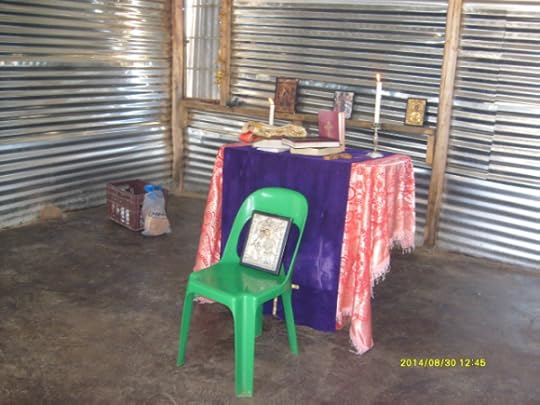
The interior of the church at Madidi.
One of the members of the congregation had died a couple of weeks earlier, so we had a memorial service for her.
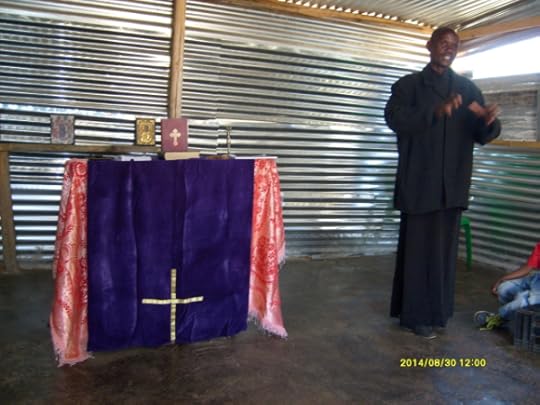
Father Markos speaking to the congregation at Madidi.
Later this month we are hoping to have a visitor from the USA, Xenia (Kaycie) Simmons, and we hope that, with the blessing of our Archbishop Damaskinos, she will be able to do some catechetical teaching at places like Madidi.
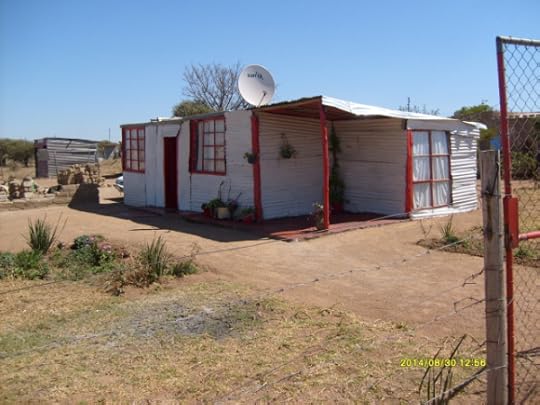
Fr Markos’s house at Madidi
We went to have a look at a piece of land that was for sale, and might be suitable for building at least a temporary church. There is about half a hectare of land available, but we are thinking of perhaps getting one or two 20 x 40 metre plots, since the land is leasehold, not freehold, and so might not be suitable for erecting substantial permanent buildings.
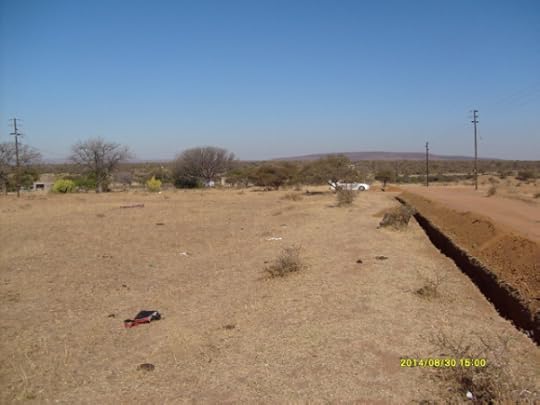
Some of the land that is availavle, and might be suitable for building a temporary church


In the memory of the forest
 In the Memoryof the Forest by Charles T. Powers
In the Memoryof the Forest by Charles T. Powers
My rating: 5 of 5 stars
Occasionally one comes across a book by pure serendipity, and this is such a book. My wife picked it up in the library, just to see what it was like, and when she had finished reading it she passed it on to me.
It is set in a village called Jadowia in Poland just after the fall of communism, and in a way is a kind of biography of a village. It is a time of transition, and so people are caught between two worlds, one of their recent history, and a new world that is coming. But the change and lifting of restrictions makes at least some of the people in the village aware of an older history, of things that had been suppressed, and had faded from consciousness — that in the past people had lived there who were no longer there, that the Jews had simply vanished, and were no longer mentioned.
In some ways the story is almost familiar, because though I have never been to Poland, South Africa was going through a similar transition in the same period, between 1990 and 1994. I also visited other countries that were undergoing similar transitions — Russia, Bulgaria and Albania. Part of the attraction of such a story is that it has some familiar echoes.
The story starts off quite slowly, and at first it is not clear where it is going, and it picks up as it goes along when the author gets into his stride. Amd then it gets quite lyrical, with what I thought were inspired descriptions, that captured the atmosphere of of time and place. Here, for example, is a description of two of the main characters, from neighbouring farms, going to the nearest town to try to get a battery for an old lamp. They walk down a street where street vendors are selling an amazing variety of goods
This spray of color, this wonderland of stuff that was almost-but-not-quite trash, things that you didn’t want but might use, things that you might buy and take home and offer as a present, a toy, a novelty, a small bright newness. Powierza stopped, fingered a pile of plastic knit gloves, and chose a pair for his wife, borrowing bills from me to pay for them. He folded them into his pocket and walked on, pausing in front of a store window offering pornographic videotapes from Germany and Holland, along with a display of electric can openers and kitchen mixers. Powierza ducked inside, received a curt response to his inquiry about a battery for the flashlight, then lingered to look at the illustrations on the videocassettes, ripe thighs tantalizingly imprisoned behind locked glass doors.
How very 1990s. How very Eastern Europe.
As I read it I had a vivid image of a lantern my father used to own, which took a battery like the one described in the book, a square cardboard-covered one. It had a big reflector on the side, for throwing a powerful focused beam, and a smaller inspection lamp on top, with a hemispherical glass cover, and a wire grill, to protect it, presumably, from dropped spanners. I haven’t seen it for 60 years, but the book brought back a clear memory of it.
All this made me wonder about the author, Charles T. Powers. How did he know all this stuff? Was he Polish? Had he lived in Poland? Had he written any other books? It turned out that he was an American journalist who had once been stationed in Poland, and that this is his only published novel. So there are no more books like this, no more where this one came from. This book is unique, and so is a uniquely good read.


August 23, 2014
Christ the Conqueror of Sin
 Originally posted on Fr. Ted's Blog:
Originally posted on Fr. Ted's Blog:
“Death is always evil and terrifying, whether it be the death of an old man or that of a child, of a just man or of a sinner. Death is always the victory of the devil, a temporary victory, yet a victory. Our body which was created for immortality, submits to the evil law of death, is separated from the soul, disrupted, stricken with decay, turned into nothing. Through sin, death has entered the world; it enters into us from our very childhood, traces the lines of sin on our faces, extinguishes the living fire in our eyes, disables our body. But Christ is the conqueror of sin and hell, and Christ’s task is chiefly the victory over death through His resurrection: ‘if Christ be not risen again, your faith is also vain.’ (1 Cor. 15,14)” (Father Yelchaninov in A Treasury of Russian Spirituality by G.P. Fedtov, p 481)


August 19, 2014
Are we too soft on terrorism
This morning I had a look at Twitter and Facebook, and was struck yet again by the depressing world we live in.
On Twitter I saw this:
Criticise the wrongs of
#islam and of#Islamism. Softness has led to a frenzy of beheading. Appeasement is a disastrous policy. End it. (from Atma Singh @PoliticoVoice)
But who is it addressed to? Who must do the criticising?
Is it addressed to the government of the USA in its self-appointed role as the world’s policeman?
But is the USA qualified to be the world’s policeman when it allows things like this?
Georgia officials refuse to pay medical bills of toddler hurt in SWAT raid:
Officials in Habersham County, Georgia, have said they will not pay the medical bills of a toddler seriously injured when a flash grenade exploded in his face during a SWAT raid in May, local media has reported.
The child, Bounkham Phonesavanh, then 19 months old, was struck with the weapon when the county’s SWAT police conducted a so-called “no-knock” raid on a home in the early hours of May 28, throwing a flash grenade into the baby’s crib. The devices – also known as flash bangs and stun grenades – are often deployed in raids and protests to temporarily disorient suspects.
It seems that if the USA acts as the world’s policeman, all we will have is a world-wide police state.
Has softness really led to a “frenzy of beheading”?
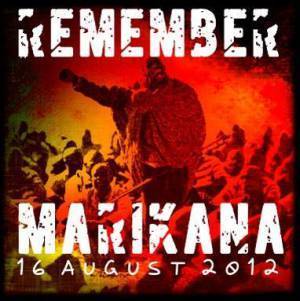 Perhaps the same “softness” that has led to children being bombed from drones, the same “softness” that led to the death of Michael Brown in Ferguson? The same softness that led to the Marikana Massacre? The same softness that has led to the killing of over 2000 people in the Ukraine civil war in the last couple of months, and an almost equal number in Gaza during the same period?
Perhaps the same “softness” that has led to children being bombed from drones, the same “softness” that led to the death of Michael Brown in Ferguson? The same softness that led to the Marikana Massacre? The same softness that has led to the killing of over 2000 people in the Ukraine civil war in the last couple of months, and an almost equal number in Gaza during the same period?
Exactly who is it who is being too soft?
Just who is “appeasing” whom?
No, the problem is not too much softness and too much appeasement.
The problem is not enough softness and not enough appeasement.
It seems that the leaders of the governments of the world major in antagonism rather than appeasement.
And then this appeared in the Progressive Orthodox Christianity group on Facebook:
Tackling the PROBLEM OF EVIL: why would a good God allows evil?
http://lotharlorraine.wordpress.com/2013/09/05/the-problem-of-evil-revisited-by-lothars-son/
What are your own thoughts on this topic?
And after reading all this stuff, I think that is yet another evasion.
We love to discuss questions about why a good God would allow evil, because by doing so we can block our ears to God’s question to us, of why we do.
Why do we allow people to be beheaded, or children to be maimed by police who then refuse to pay their medical bills?
There’s an Anglican hymn that goes like this:
New every morning is the love
our wakening and uprising prove;
through sleep and darkness safely brought,
restored to life, and power, and thought.
And fifty years ago Paul Dehn published a parody, which is just as true today:
New every morning is the love
with which our ministers approve
devices new and up to date
for fostering the same old hate.
No, the problem is not that we are too soft; it is that we are too hard-hearted.
The most vexing question is not why a good God would allow evil, but why we do.


August 12, 2014
A taste for horror
 Busman’s Honeymoon by Dorothy L. Sayers
Busman’s Honeymoon by Dorothy L. Sayers
My rating: 4 of 5 stars
I finished reading this book a couple of days ago, and it’s a classic whodunit combined with a love story. In this particular edition the foreword was written by Elizabeth George, whose crime novels also feature an aristocratic detective and his love life.
In this story the amateur sleuth, Lord Peter Wimsey, has married Harriet Vane, and their honeymoon is complicated by the discovery of the corpse of the previous owner of the house they have just bought.
I’ve read a couple of other whodunits by Dorothy Sayers, and while I’ve enjoyed them, I would not say that they are the best detective fiction I have read. Sayers is sometimes linked with the informal literary group the Inklings, and though not actually a member, she was a friend of some of the members, and they sometimes read her work at meetings.
When I read Sayers’s novels, I am very conscious of the period they are set in, and in which they were written, and so I’m also very aware of it being another age, another world. It is the world of Downton Abbey. Indeed, perhaps seeing Downton Abbey enables one to appreciate her stories more.
By contrast, when reading books by Inklings Charles Williams and C.S. Lewis I’m not so conscious of the period in which they are set. Though Lewis’s descriptions of Mars and Venus are nothing like what we now know them to be, one can suspend disbelief for the sake of the story. And even though Williams’s novels are set on earth, there is nothing quite as dated as the descriptions in Sayers, perhaps because she gives more details of everyday life — characters smoking, ordering food, taking care of wine and the like.
There’s also a lot of erudite literary wordplay between the amateur and the professional detective, which is a bit spoilt by the slightly patronising tone. Of course back then being patronising was regarded as a good thing, noblesse oblige and all that. But there’s another thing — the characters keep breaking into French, with no hint of a translation. I suppose in that era educated Englishmen (of both sexes) could be expected to converse freely, if not fluently in French, but that too just makes one aware of how much times have changed.
But Dorothy Sayers nevertheless had a great influence on my literary tastes and preferences, not through her detective fiction, which I only began reading in this century, but through a collection of short stories she edited:
 Great Short Stories Of Detection, Mystery And Horror by Dorothy L. Sayers
Great Short Stories Of Detection, Mystery And Horror by Dorothy L. Sayers
When I was a child we had this work on our bookshelves, in three volumes, just like the one in the illustration, but they disappeared in several moves, when my mother got rid of a lot of surplus possessions. I read many of the stories, but my favourites, the ones I reread many times, were those in the “horror” section, and it was this book that gave me a taste for horror stories.
It was more than fifty years ago now, but the stories that made the biggest impression on me, that I read and re-read, were “The Wendigo” by Algernon Blackwood and “Couching at the door” by D.K. Broster. After the books disappeared I sometimes wanted to read them again, but I could only remember the titles of some of the stories, and not the names of the authors, and I thought I would never find them again.
And then along came the Internet, with its access to knowledgeable people, and other resources. A web search engine quickly found the authors of both these stories, and “The Wendigo” was available in downloadable form. And so I discovered the author of …
 Couching at the Door (Wordsworth Mystery & Supernatural) by D.K. Broster
Couching at the Door (Wordsworth Mystery & Supernatural) by D.K. Broster
… which immediately went on to my “want to read” list.
The collection, Detection mystery and horror by Dorothy L. Sayers gave me the taste for horror stories, but also determined the kind of horror stories I would like. I greatly enjoyed Dracula, but that spoiled all other vampire stories for me. Stephen King’s ‘Salem’s lot was a bit of a let-down, and Anne Rice’s vampire stories horribly boring. I doggedly read through Interview with the vampire just to be able to say that I had read it, but the experience was even worse than reading Ayn Rand. I suppose the one merit of the story was that it was shorter than Atlas shrugged.
Stephen King did, however, write a half decent story that features the Wendigo, Pet Sematary, not as good as Blackwood’s story, but good in its own way.
So, thanks to Dorothy Sayers, I like a good horror story. It’s just a pity that there are so few good ones about, and so much dreck. Sayers collected the best that was available at her time, but I came across another collection of stories, contemporary with hers, called The abominartions of Yondo, edited by Clark Ashton Smith. The collection seemed to be full of the genre of horror writers who tried to create an effect by piling epithet upon epithet, until the words wore out and lost their meaning. “Eldrich” seemed to be a particular favourite, with “nameless” a close second. H.P. Lovecraft sometimes seems to have c ome close to joining this school, but not quite.



